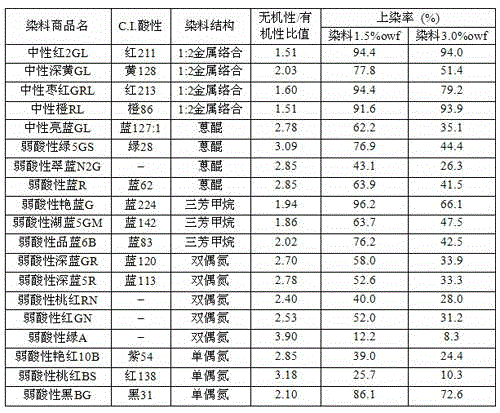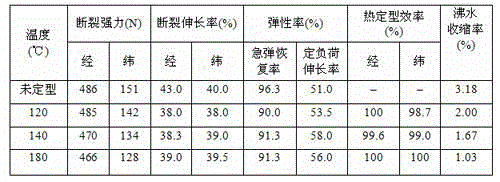Processing method of mucilage glue elastic shell fabric
A processing method and fabric technology, which is applied in the processing of textile materials, fabric surface trimming, heating/cooling fabrics, etc., can solve the problems of continuous shrinkage of finished products and poor dimensional stability, and achieve reduced shrinkage, good stability, and improved performance. Good results
- Summary
- Abstract
- Description
- Claims
- Application Information
AI Technical Summary
Problems solved by technology
Method used
Image
Examples
Embodiment 1
[0021] A processing method of viscose elastic fabric, comprising the following steps:
[0022] Step 1, pretreatment, immerse the viscose elastic fabric in a bath ratio of 1:40 in soda ash at a temperature of 50°C and a mass volume ratio of 0.5g / L for 30 minutes;
[0023] Step 2, preliminary training, soak the pretreated fabric in the mixed solution I at a temperature of 60°C for 50 minutes at a bath ratio of 1:40, and the mixed solution I is composed of a mass-volume ratio of 0.5g / L soda ash, 2g / L Composition of L natron, 8g / L liquid soap 852, 2g / L Remibond A and 0.4g / L hydrosulfate;
[0024] Step 3, re-training, soak the initially trained fabric in the mixed solution II at a temperature of 90°C at a bath ratio of 1:40 for 50 minutes. The mixed solution II is composed of 0.8g / L soda ash and 3g / L Composition of L-naphthine, 12g / L liquid soap 852 and 0.3g / L hydrosulfite;
[0025] Step 4, wash the retrained fabric successively with hot water at 95°C, hot water at 80°C, wate...
Embodiment 2
[0029] A processing method of viscose elastic fabric, comprising the following steps:
[0030] Step 1, pretreatment, soak the viscose elastic fabric with a bath ratio of 1:50 in soda ash at a temperature of 70°C and a mass-to-volume ratio of 0.8g / L for 40 minutes;
[0031] Step 2, preliminary training, soak the pretreated fabric in the mixed solution I with a temperature of 90°C for 70 minutes at a bath ratio of 1:50, and the mixed solution I is composed of 0.8g / L soda ash, 2.5g Composition of / L natron, 10g / L liquid soap 852, 3.5g / L Remibond A and 0.5g / L hydrosulfite;
[0032] Step 3, retraining, immerse the initially trained fabric in a mixture solution II at a temperature of 95°C for 70 minutes with a bath ratio of 1:50, and the mixture solution II is composed of 1g / L soda ash and 2.5g / L Composition of natron, 16g / L liquid soap 852 and 0.5g / L hydrosulfite;
[0033] Step 4, wash the retrained fabric successively with hot water at 95°C, hot water at 80°C, water at 60°C,...
Embodiment 3
[0037] A processing method of viscose elastic fabric, comprising the following steps:
[0038] Step 1, pretreatment, immerse the viscose elastic fabric in a bath ratio of 1:60 in soda ash at a temperature of 80°C and a mass volume ratio of 1.2g / L for 50 minutes;
[0039] Step 2, preliminary training, soak the pretreated fabric in the mixed solution I at a temperature of 80°C for 70 minutes at a bath ratio of 1:60, and the mixed solution I is composed of a mass-volume ratio of 1.5g / L soda Composition of L-naponine, 11g / L liquid soap 852, 5g / L Remibond A and 0.8g / L hydrosulfite;
[0040] Step 3, retraining. Soak the initially trained fabric in the mixed solution II at a temperature of 110°C for 80 minutes at a bath ratio of 1:60. The mixed solution II consists of a mass-volume ratio of 1.2g / L soda Composition of L-naphthine, 18g / L liquid soap 852 and 0.8g / L hydrosulfite;
[0041] Step 4, wash the retrained fabric successively with hot water at 95°C, hot water at 80°C, wate...
PUM
 Login to View More
Login to View More Abstract
Description
Claims
Application Information
 Login to View More
Login to View More - R&D
- Intellectual Property
- Life Sciences
- Materials
- Tech Scout
- Unparalleled Data Quality
- Higher Quality Content
- 60% Fewer Hallucinations
Browse by: Latest US Patents, China's latest patents, Technical Efficacy Thesaurus, Application Domain, Technology Topic, Popular Technical Reports.
© 2025 PatSnap. All rights reserved.Legal|Privacy policy|Modern Slavery Act Transparency Statement|Sitemap|About US| Contact US: help@patsnap.com



